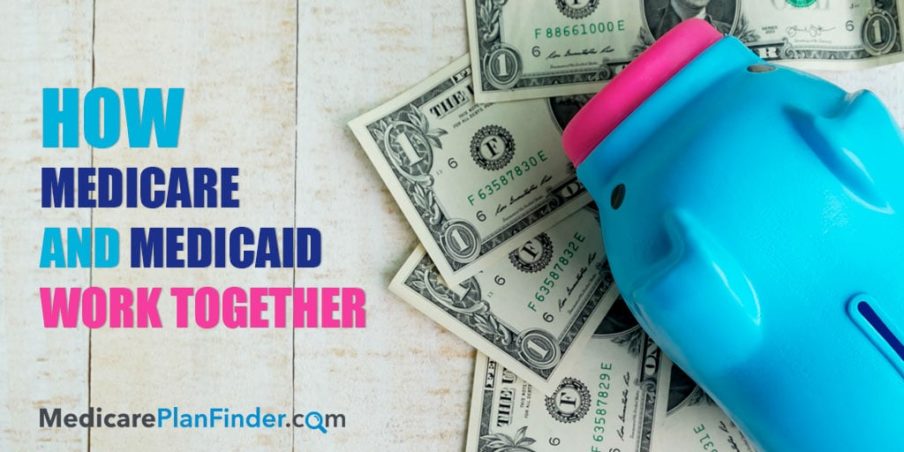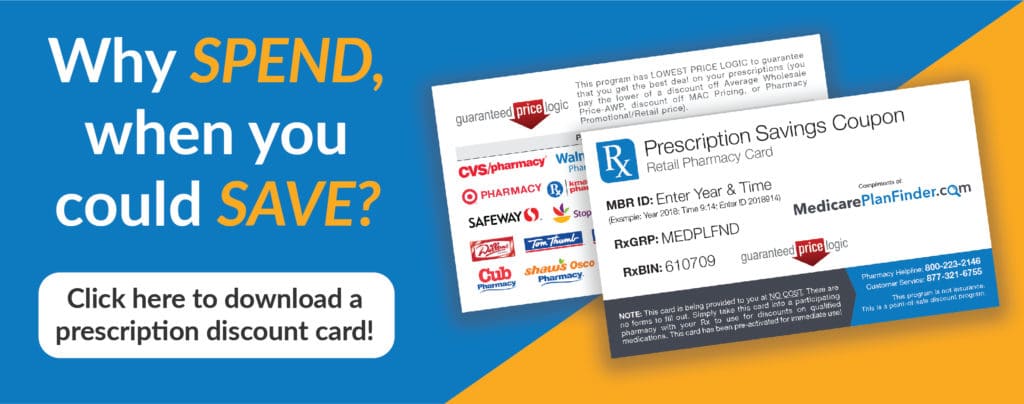
How Medicare and Medicaid Work Together
April 3, 2019Medicaid helps lower the cost of Medicare for more than 12 million dual-eligibles. In fact, Medicaid is the nation’s largest public health insurance program for people with low income and covers more than 1 in 5 Medicare enrollees. Are you eligible? Here is everything you need to know about Medicaid, Medicare, eligibility, costs, and savings programs.
What is the difference between Medicare and Medicaid?
Medicare and Medicaid can be easily confused, but they are two separate government-operated programs. Medicare is a federal program that provides health coverage for seniors over 65 and other Medicare-eligibles, regardless of your income. Medicaid is a state and federal program that provides health coverage for those with low income. However, if you are dual-eligible, you are eligible for both Medicare and Medicaid. This allows you to expand your network to include Medicaid doctors and decrease your out-of-pocket healthcare costs.
Those who are over 65 and those who receive SSDI (Social Security Disability Insurance) are eligible for Medicare.
Medicaid eligibility is different in every state and is largely based on income level. Though this varies by state and marital status, if you know that you are under the Federal Poverty Level, there’s a good chance that you qualify for Medicaid.
Can you Have Medicare and Medicaid?
If you are dual-eligible, that means you’re eligible for both Medicare and Medicaid. That can mean that you are both low-income and over 65, both low-income and on dialysis for ESRD, or any other qualifier listed below.
When you have both Medicare and Medicaid, Medicare will cover you first. Your Medicaid will serve as sort of a backup plan when you need more coverage than Medicare can provide.
People who are eligible for both Medicare and Medicaid may qualify for a Dual-Eligible Special Needs Plan, or DSNP. DSNPs often come with very low or $0 premiums, and Medicaid often covers the resounding copayments. DSNPs are not available in every area, and each plan can be a bit different, so be sure to ask your agent.
Dual-eligible beneficiaries are sometimes eligible for a Medicare Savings Program (MSP) as well. An MSP can help you pay for your Medicare premiums. You’ll also be enrolled in Extra Help, a program that helps you pay for your Medicare prescription drug costs. You may hear Extra Help referred to as LIS, or Low-Income Subsidies.
Bonus: if you are eligible for both Medicare and Medicaid, you have a Special Enrollment Period (SEP). That means that you don’t have to wait for the Annual Enrollment Period (AEP) to enroll or make changes to your plan.

Medicare and Medicare Eligibility Check
Ready to find out if you are eligible for Medicare? Do you fall into any of the below categories?
- I am over the age of 65 or will be turning 65 within the next few months.
- I have ESRD (End-Stage Renal Disease/Kidney Failure) and am receiving dialysis treatment.
- I have Lou Gehrig’s disease (amyotrophic lateral sclerosis or ALS).
- I have received Social Security Disability Income for over 24 months.
- I receive retirement/disability income from the Railroad Retirement Board.
Note that to qualify, you also must be a U.S. citizen.
Medicaid eligibility is going to depend largely on what state you live in. While Medicare is more federally regulated, Medicaid is mainly state-regulated. For example (2018), in Tennessee, a family of four can qualify for Medicaid with an income of less than $32,718 annually. However, in New York, a family of four can only qualify for Medicaid with an income of less than $32,319.
Some of the groups that most commonly pass the Medicaid eligibility check are U.S. citizens like:
- Those under 21 with low income
- Pregnant women with low income
- Low-income parents of minors
- Low-income women undergoing breast or cervical cancer treatments
- Those who receive Social Security benefits
- Individuals who live in nursing homes or receive other long-term care and require financial assistance
If you think you are eligible, you can access the Medicaid Application for every state from the Healthcare Marketplace website.
Medicaid Doctors and Costs
A great way to find providers in your area who accept Medicaid is by using an online search tool like “DocSpot.” From DocSpot, you’ll enter your city, your type of coverage (Medicaid), and the type of doctor you are looking for. DocSpot will populate results for you where you can read reviews and pick Medicaid doctors in your area that you can schedule an appointment with.
If you have both Medicare and Medicaid, you can expand your doctor network to also include those who accept Medicare. If you have Medicare Advantage (a Medicare plan offered by private companies instead of the federal government), you’ll want to use your plan’s website to search for a provider that accepts your coverage.
Your Medicaid, Medicare, and Medicare Advantage costs will all depend on your financial status and the type of plan you select.
Medicaid Prescription Drug Costs
Technically, prescription drug coverage is an optional federal Medicaid benefit. Since Medicaid is a state-based program, all states determine their own prescription drug coverage. Currently, all U.S. states provide outpatient prescription drug coverage to eligible Medicaid beneficiaries. Depending on your state, you will receive either free or heavily discounted prescription drugs when receiving Medicaid benefits.

Additional Medicaid Costs
Some Medicaid beneficiaries will be required to pay copayments for certain services. It all depends on your income. For example, for non-institutional care (such as a doctor’s office visit), anyone at 100% of the federal poverty level will have to pay a copay of $4.00. Anyone whose income is 150% above the federal poverty level will have to pay 20% of the costs. Keep in mind that the federal poverty level can change every year and also takes into account the number of people living in your household.
Medicare Extra Help Application
If you have Medicare but do not qualify for Medicaid, fear not! You may still qualify for financial assistance in another form: Medicare Extra Help.
Medicare Extra Help, otherwise known as LIS (Low-Income Subsidies), helps you cover your prescription drug costs that Medicare does not cover. To qualify for Extra Help, you must first have Original Medicare (Part A and Part B). You cannot have savings, investments, and real estate that total more than $28,150 (or $14,100 if you are single).*
Medicare Savings Program Application
Even if you do not qualify for full Medicaid benefits or if you don’t qualify for Medicare Extra Help, you can still qualify for a Medicare Savings Program. There are four Medicare Savings Programs:
Qualified Medicare Beneficiary (QMB)
Pays for Medicare Part A and B premiums, deductibles, coinsurance, and copayments. Also makes you eligible for Medicare Extra Help. To qualify for QMB, you:
- Cannot exceed individual monthly income limit of $1,032
- Cannot exceed married monthly income limit of $1,392
- Cannot exceed individual assets limit of $7,560
- Cannot exceed married assets limit of $11,340
Specified Low-Income Beneficiary (SLMB)
Pays for Medicare Part B premiums. Also makes you eligible for Medicare Extra Help. To qualify for SLMB, you:
- Cannot exceed individual monthly income limit of $1,234
- Cannot exceed married monthly income limit of $1,666
- Cannot exceed individual assets limit of $7,560
- Cannot exceed married assets limit of $11,340
Qualifying Individual (QI)
Pays for Medicare Part B premiums. Also makes you eligible for Medicare Extra Help. To qualify for QI, you cannot have Medicaid and you:
- Cannot exceed individual monthly income limit of $1,386
- Cannot exceed married monthly income limit of $1,872
- Cannot exceed individual assets limit of $7,560
- Cannot exceed married assets limit of $11,340
Qualified Disabled & Working Individuals (QDWI)
Pays for the Medicare Part A premium if you are working, disabled, and under 65 OR if you lost your premium-free Part A when you went back to work. You must not be receiving state medical assistance. You also:
- Cannot exceed individual monthly income limit of $4,132
- Cannot exceed married monthly income limit of $5,572
- Cannot exceed individual assets limit of $4,000
- Cannot exceed married assets limit of $6,000
Access the Medicare Savings Program Application here.
Medicaid Application
Think you are eligible for Medicaid? You can apply either online through the Health Insurance Marketplace or through your state Medicaid agency. To use the Health Insurance Marketplace Medicaid Application, click here.
Each state has its own Medicaid Application on its own Medicaid website. It may be a good idea to meet with an agent first so that you can get help with your application.

Are you eligible for Medicare and Medicaid?
If you’re not sure whether or not you are eligible for Medicare and Medicaid, we can help. Give us a call and we’ll ask you a series of questions to help you find out if you’re eligible.
If you are eligible, we can send an agent to your home to help you sort through your health care options. Another perk of being eligible for both Medicare and Medicaid is that you can receive a Special Enrollment Period, meaning that you can make changes to your coverage during any time of the year and don’t have to wait for the Annual Enrollment Period in the fall.
Our agents are licensed to sell plans from multiple different carriers, so they can help you pick the plan that truly works best for you.
To get started, give us a call at (833)-567-3163 or click here.
This post was originally published on March 15, 2018, and was updated on September 28, 2018, and updated again on April 3, 2019.

